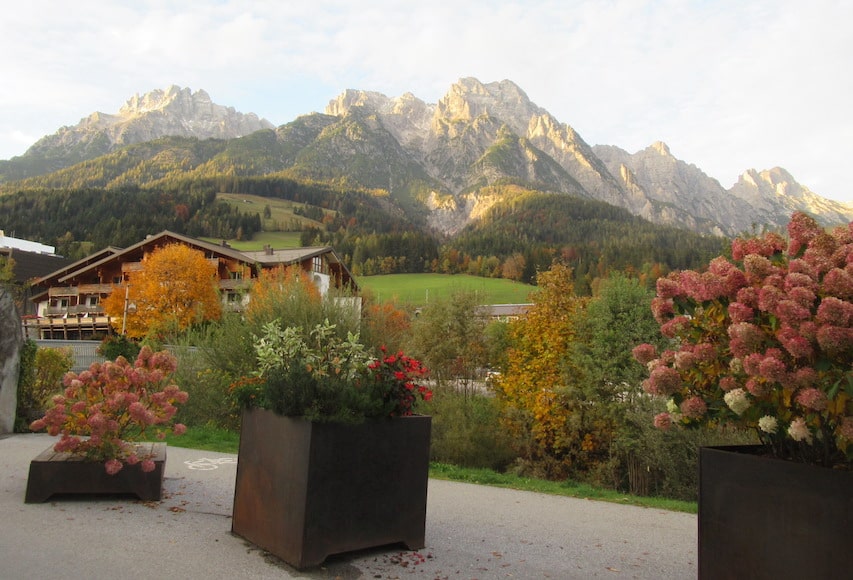
The relationship between meadows and forests is changing in Austria’s Alpine mountains because of climate change. New opportunities, however, require new ways of thinking and management. Photo by Mark Orwoll
By Mark Orwoll
“Griass di!”
No clue. I’d been in Vienna for the past three days, where most people greeted you with Grüss Gott or Guten tag. But now, here in the Alps of Austria’s Saalfelden Leogang, the dialect has changed. Maybe it’s because of the region’s remoteness. Maybe it’s simply tradition. Or maybe it’s because Griass di is from a Bavarian dialect and the Bavarians own these Austrian Alps.
Wait, what?!
Well, own might be an overstatement. The Bavarian-Austrian Salt Treaty of 1829 is often cited as the longest-existing treaty in Europe. The agreement codified a 600-year-old understanding between the Kingdom of Bavaria (now the Free State of Bavaria) and the Austrian Empire (now the Republic of Austria) that allowed the Austrians to extend their deep salt mines under the mountains and into adjacent Bavaria. In exchange, Bavaria gained the forestry rights to those same Austrian Alps. The salt mines are now depleted, but the Bavarians are still harvesting the lumber, nearly 200 years later. Sounds like a bad deal for Austria.
“Not really,” says Anna Heuberger, whose title can barely fit on a business card. She’s a climate-change adaptation model regional manager for Pinzgau, the larger region surrounding Saalfelden Leogang. “Nobody complains. The Bavarians get a little profit from the trees, but they put most of it back into managing the mountains.”
Birnbachloch’s Mountain Mamas
I’m hiking up an alp called Birnbachloch with Heuberger and her volunteer assistant, Iris Hutter, to see some of the effects of climate change on these mountains. The Alps here are more rugged than the ones on which Julie Andrews sang “The Sound of Music.” Here you won’t find softly rounded hilltops but jagged peaks, precipitous drops, and meadows as steep as a ladder. I’m afraid a misstep on the narrow path will send me hurtling down a 2,000-foot crevasse. Heuberger, on the other hand, 30 years my junior, is bouncing down the trail like a happy-go-lucky mountain goat.
Heuberger is a university-trained environmental engineer in charge of a 2,600-square-kilometer (app. 1,000 square miles) territory. To drive along its borders you’d be in a car for about two and a half hours, she tells me.
“Our task,” she says, “is to identify the environmental problems, determine best practices for engineering measures, and try to get the local people to adopt them.”
That would be difficult enough if the climate concerns were the same throughout the region, but they’re not. At least, not here in Saalfelden Leogang.
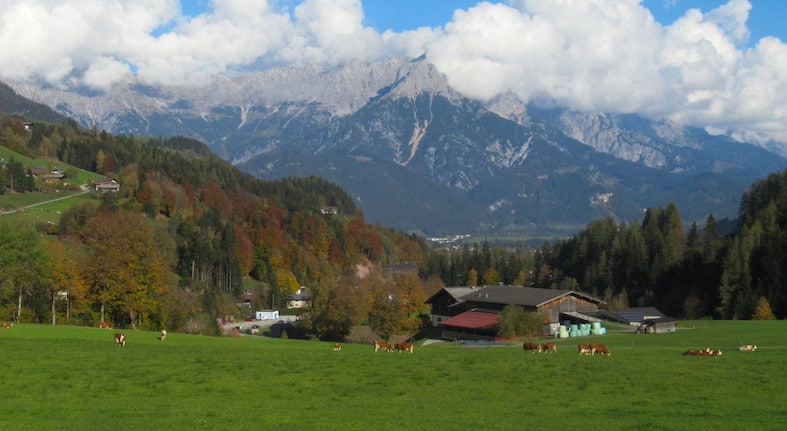
Saalfelden Leogang is largely defined by soaring mountainscapes and alpine meadows. Photo by Mark Orwoll
Something’s Happening Here. What It Is Ain’t Exactly Clear
“The summers up here aren’t getting dryer,” she says, waving an arm at the surrounding mountains. “We’re having more intensive precipitation events. We often have too much water, which can be destructive.”
That can cause boulders to tumble from the alpine heights down into the valleys. Erosion of the mountainsides is an increasing concern. At the same time, beautiful mountain meadows and the broad alpine vistas they provide are being reclaimed by the forest. The meadows are the traditional summer pastures for livestock, but fewer and fewer farmers are willing to do the hard work of maintaining those often remote high-altitude meadows through regular mowing and removal of young conifers. Beyond the aesthetic concerns, biodiversity suffers from the loss of meadows.
Saalfelden Leogang is not all up-and-down peaks and deep gorges. Much of the region comprises a broad agricultural valley centered on the town of Saalfelden (population 17,000). To the west, the valley narrows into a mountain-bordered canyon leading to the village of Leogang (population 3,200). The two dozen or so hamlets and villages in between fall into the destination called Saalfelden Leogang.
So Near and Yet So Far
The location is central to everything: a five-hour drive to Venice, a four-hour drive to Vienna, two hours to Munich, and just an hour or so to Salzburg. Yet it’s just far enough off the main travel routes that most people are unlikely to pass through it. Unless they’re trying.
I tried. Mainly, I wanted to know more about the people here, their traditions, the climate threats to their way of life, how things are different now, and how they’ve stayed the same. When I was offered the chance to meet a saffron farmer in the valley, I hopped to it, because saffron is not a high-altitude crop. Think hot, dry lands like Spain and, especially, Iran, which produces 90 percent of the world’s saffron. So what’s saffron doing in the Alps?
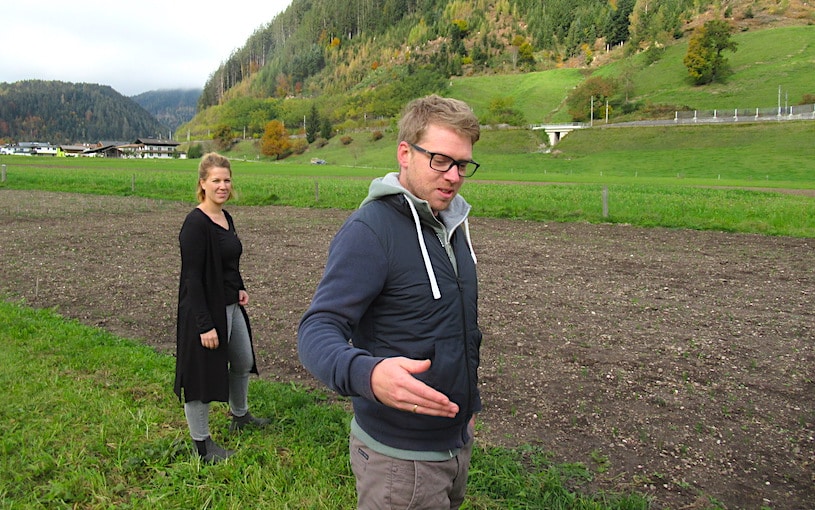
George and Carina Wölfler hope saffron will become a revenue-producing cash crop. Photo by Mark Orwoll
George and Carina Wölfler got the wild idea to raise saffron in 2019 after George’s uncle Leonhardt Mayrhofer gave them a small patch of ground on which to experiment. Unfortunately, George was no farmer. By profession, he is a government registrar, adding birth and marriage data to bureaucratic logs. He and Carina had no idea if raising saffron could be done. To find out, they planted 250 plumes of saffron. And prayed.
The experiment was a modest success. Today, they harvest saffron once a year. They have no marketing or media budget. They don’t grow enough to become full-time saffron growers or sell it at the retail level, but word of mouth sends the occasional consumer their way. Those fortunate enough to find their place can purchase one gram (3/10 ounce) of saffron for 150 euros (U.S.$150).
The difference between expensive real hand-picked saffron and the kind purchased for a few dollars in supermarkets is the quality. Is the saffron pure or has it been adulterated with chemicals to enhance the aroma, synthetic dyes to mimic the deep red color, and turmeric and paprika to give it flavor?
“The first thing,” says George, smiling at his wife and his mother standing in their field, backdropped by the Alps, “is having all our family working together. The second is to produce the highest quality of saffron.”
They currently have only one major buyer, a restaurant, but with the success of their first three years, George is hopeful of building up the business.
“When I was a young boy, the area was much different,” George says. From where we stand, we can see dozens of other farms in the shadows of the Alps. “There was much more corn then. Farmers grew different crops than their neighbors. Each field seemed to be a different color, depending on what they were growing. Then the dairy industry began to grow and take over the crop farms. The next stage depends on the climate. It’s getting warmer and dryer in the valley. Maybe wine will be the next industry here.”
George and Carina have no plans to leave, no matter what happens. As the valley adapts to changing climate and a changing economy, they too will adapt. Their experiment with saffron is just an example. Besides, they like it here.
“You have everything here you need in life,” George says, smiling as he looks around at the nearby farms, the peaks, and busy Saalfelden in the far distance. “There’s no criminality. The education is very good. We have sun, we have snow. And for us, it’s pretty good!”
Austria’s Artisanal Farmers
A short drive from the Wölflers’ saffron patch is Zieferhof, the organic dairy operation managed by Bernhard and Lisa Perwein. It takes its name from their 300-year-old farmhouse, which these days accepts overnight guests. Its 40 milk cows may not sound like a lot, but a herd that size is considered normal in these parts.
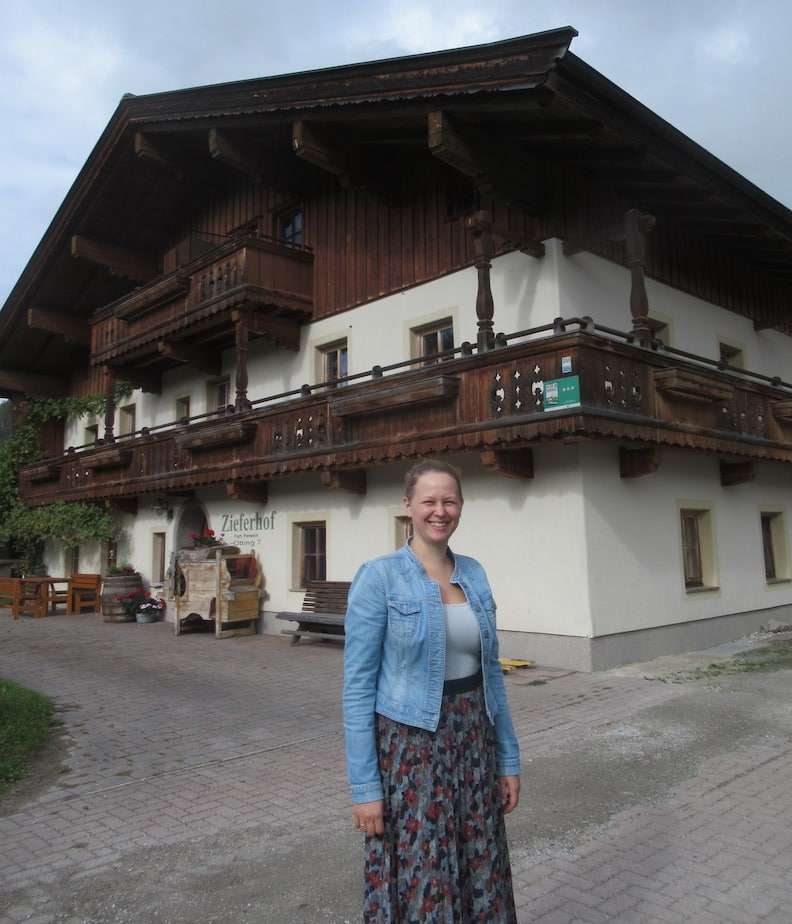
Lisa Perwein helps manage the Zieferhof dairy farm out of her family’s 300-year-old farmhouse. The farm uses milk from its 40 cows to make cheese and yogurt. Photo by Mark Orwoll
“This is a very special way of farming,” says Lisa Perwein during a break from her daily chores. “We make our own cheese and yogurt. We have a little shop. We sell to larger dairies. We also sell to gift shops and deliver to private customers. We even make apple wine.”
The prices at the farm shop may be higher than those in a large supermarket, but here you’ll find fresh buttermilk, natural yogurt made on site, and artisanal liqueurs.
Perwein can’t say for certain if their craft-like approach to dairy is sustainable. The multifarious pressures on small farmers seem to get greater and greater with each passing year, she explains.
“It’s hard to say what the future will bring, because of the climate crisis,” she continues. “Also, now the farmer has to do the marketing, meet the customers, milk the cows, and run the gift shop and the inn. It becomes more difficult as we grow.”
An Alpine Horn & Hardart
Small farmers in Saalfelden Leogang are used to adapting to change. The Haitzmann family, which owns the Stechaubauer organic “bio farm” just to the east of Perwein’s property, has implemented a novel approach to the old-fashioned farmstand. Instead of manning the stand for 12 hours a day or relying on the risky honor system, they’ve devised an automated arrangement.
The Gemüsehütte Stechaubauer (Stechaubauer vegetable shack), as it’s called, is a self-service outlet in a cute wooden hut that sells fresh produce in the style of a 1940s Manhattan Horn & Hardart automat. Customers select vegetables through small glass doors, tap a credit card (instead of dropping a nickel in a slot), open the door, and voila! The retro-modern stand, which opened a year and a half ago, is open 24 hours a day.
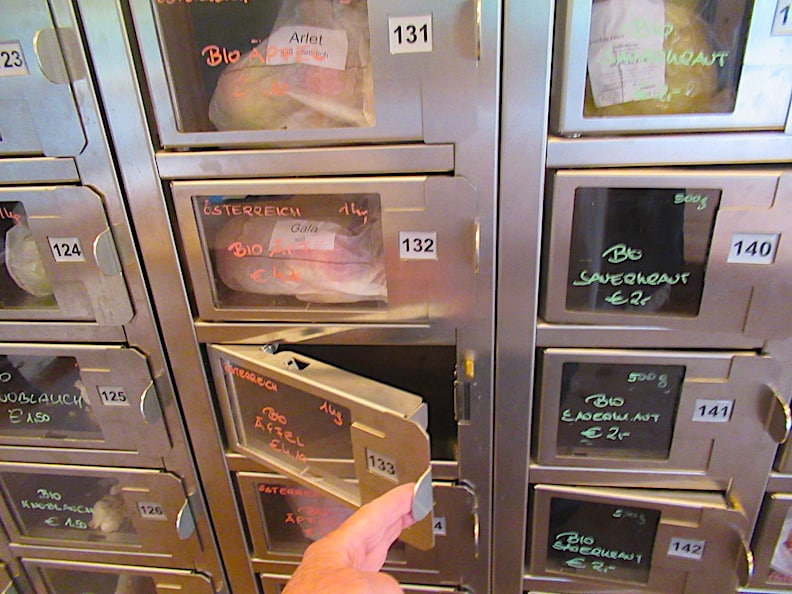
Back to the Future. The Gemüsehütte Stechaubauer, which translates as the “Stechaubauer vegetable shack,” borrowed an idea from an early 20th Century automat called Horn & Hardart and sells its products out of cubicles that can be unlocked with a credit card. Photo by Mark Orwoll
Throughout Saalfelden Leogang, the recent changes have been enormous. Too much rain! Too dry! Saffron! Artisanal dairy farmers! Automated vegetable stands! And one day, who knows, maybe…wine?! All those changes seem even more dramatic after a visit to the Mining & Gothic Art Museum Leogang.
Andreas Herzog, a native of Saalfelden Leogang, joined the museum staff five years ago and became director in September 2022. The museum, a private institution, was founded 30 years ago by its director and chairman, Hermann Mayrhofer, to preserve the 3,200-year-old mining history of Leogang. But what’s the connection between mining, Gothic art, and Saalfelden Leogang?
“There’s a big connection,” says Herzog. “In the Middle Ages, the mining industry flourished here, and the profits went to art. Flourishing mining meant flourishing art.”
The museum, which opened in a pair of 16th-century buildings in 1992, sits in the tiny hamlet of Hütten, one of the handful of communities that make up Saalfelden Leogang. There’s not much else there—a tavern from 1521, a few houses, the 18th-century St. Anne’s Chapel—but it’s picturesque, hidden from the main highway, and old in a good way.
There are mining saints, dozens of them, I discover. Each group of tunnelers had its patron saint. The workers in the smelter in Hutten, for example, prayed to St. Laurencias. The silver miners looked to St. Anne for protection in the dark and often dangerous tunnels from which they also extracted copper and cobalt. The emeralds in the crown of the late Queen Elizabeth are from Leogang, says Herzog.
Cobalt Blue: The Color of Money
“Mining is why Leogang was so important,” says Herzog. “Five hundred years ago they used our cobalt to make blue glass for stained-glass windows. In cathedrals across Europe, there’s a piece of Leogang.”
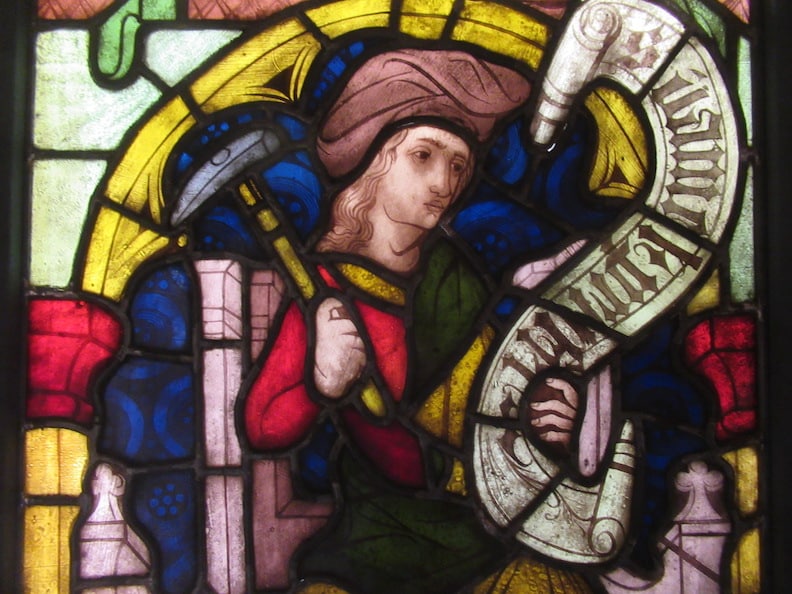
Silver mines brought prosperity to Saalfelden Leogang 500 years ago. A byproduct of the mines was cobalt, which was used to color blue glass that still exists in stained glass cathedral windows throughout Europe. Photo by Mark Orwoll
The museum, though relatively small and little known to the average traveler, has a large presence in the wide world of museum curators.
“We have a huge network of experts, museums around the world, even former members of the Hapsburg royal family.”
It’s easier to appeal to royalty, however, than the average man in the street.
“Now we get twenty thousand visitors a year, in a village of only three thousand people. But we are a practical people in this museum,” says Herzog. “We realize we don’t get a lot of appreciation from the people who live here. We’re much better known outside than right here. But it’s not a problem for us. We invite the inhabitants to visit for free. Local awareness is increasing. We want the people of today to marvel at our past.”
But the greatest change to Saalfelden Leogang is skiing and the attendant hotel/restaurant/tourism infrastructure, especially in the deep canyons and on the challenging mountain slopes of Leogang.
“When the mines closed, tourism began,” says Herzog. “That’s where the money was. Forty years ago, this valley was filled with farms. Now there are hotels where they used to grow crops and raise cows. It was very poor here back then. Now it’s rich—through tourism.”
Echoing that sentiment is Berrie van de Kolk, a Dutchman who came to the region some 20 years ago. Van de Kolk is now the marketing and office manager of Leoganger Bergbahnen, which, among other enterprises, runs the gondola systems on the Asitz skiing mountain and the Epic Bikepark Leogang, one of Europe’s first and largest mountain-biking trail systems.
“Saalfelden was built on trade,” says van de Kolk, “and Leogang was built on mining. Then the mining was gone.”
Van de Kolk crystallizes the recent changes when he says, “Fifty years ago, there was hardly any tourism and winter recreation, so local investors developed a ski area on the Asitz mountain.” Skiing, especially in Leogang, is now the primary winter activity, but the local tourism poohbahs are also developing year-round travel offerings.
Beyond the ski slopes, Saalfelden Leogang hosts the Mountain Biking World Cup. A jazz festival has been held every August for more than 40 years. In the summers, thousands of visitors ride the Asitzbahn gondolas to the top of the ski mountain, where they enjoy not only hiking and the warm-weather views but also the gigantic “Tonspur Islands”—rest areas with huge lounge chairs and classical music coming from hidden speakers. Then, when they’re done, they can take the gondolas down the mountain and enjoy the amenities at any of a dozen luxe resorts and hotels.
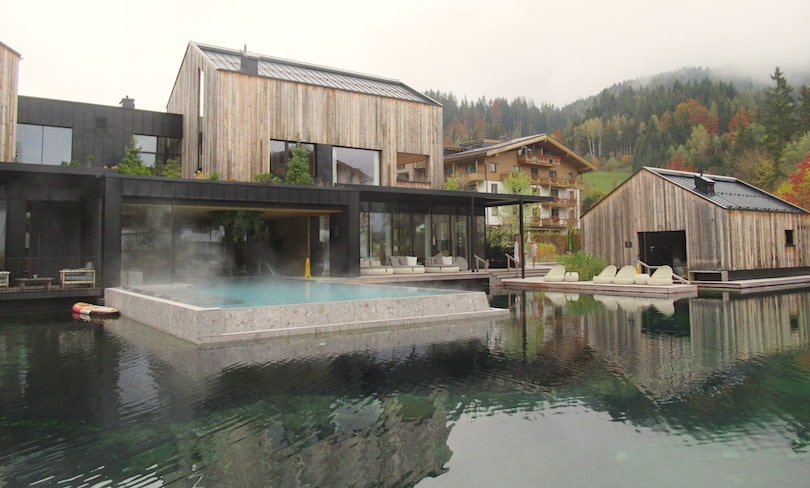
Mining. Agriculture. Tourism. The progression now is producing properties like Forsthofgut Naturhotel, a luxury hotel that pampers holiday guests. Photo by Mark Orwoll
There’s nothing new in that. “Ski villages,” artificial as they may be, have long pampered guests from California to Colorado to the Swiss Alps and beyond. On this trip, I found myself staying at one of the finest properties in Saalfelden Leogang, the family-run Forsthofgut Naturhotel.
The first part of the resort’s name comes from the hostelry’s original 17th-century building, a farmhouse, still standing. The Schmuck family, which bought the farm in 1905 and still owns the resort today, rented rooms to their first holiday guests in 1960.
Today the resort has multiple pools, saunas, spa treatment rooms, restaurants, nonstop mountain views from virtually every window, and even a brand-new equestrian facility, where guests can rent a horse or temporarily stable their own. There are family pools and adults-only areas (no clothing in the sauna). And that’s just one of dozens of hotels that have risen up here in the past 30 years.
But even the ski resorts, like the farmers, are having to deal with the impact of climate change.
“The snow is coming a little later,” says Sabine Enzinger, who operates Elements Outdoor Sports in Leogang. In summer, her company runs a mountain biking school; in winter, a school for off-piste skiing and avalanche training. “The ski season,” she says, “is getting shorter and shorter.”
The Witchy Woman of Leogang
Harking back to older times, though, is Maria Enzinger. In her poncho and floppy hat, she looks more like a Peruvian villager or aging hippie than a university-trained biologist, which she is. Enzinger, who offers walking tours, is also an herbalist, sometimes referred to, affectionately, as a kreiderhexer, an “herb witch,” because of her knowledge of medicinal alpine plants. She strolls the grounds of the Asitz mountain gondola’s middle station, plucking marigolds, juniper berries, worm ferns, and other potent botanicals that will give a person “strong blood,” heal wounds, protect against snake bites, or regulate one’s thyroid.
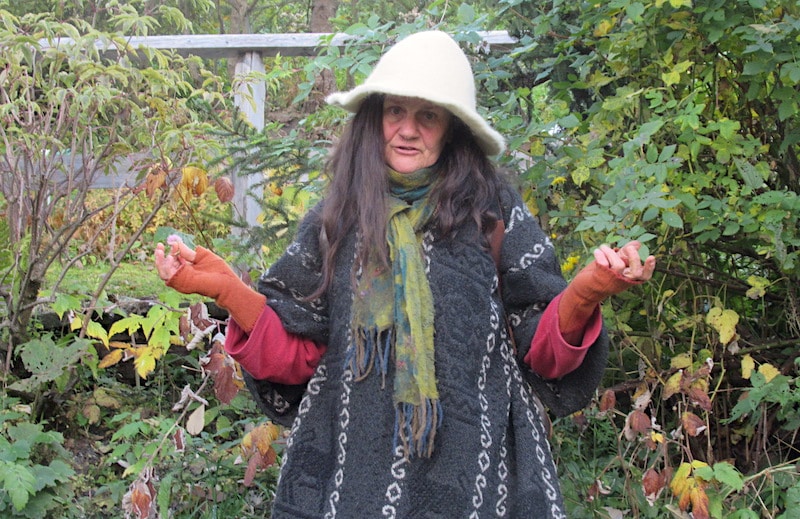
Maria Enzinger, a specialist in medicinal alpine plants, leads botanical tours through the mountain meadows of Saalfelden Leogang. Photo by Mark Orwoll
She makes the point that she’s not a physician, but says, “I give people information about what they could try themselves.” She says awareness of natural cures is starting to break out of the fringe and into public acceptance. “It’s coming,” she says. “It doesn’t come quickly, but it’s coming.”
Back to the Future
Forward, into the past. Saalfelden Leogang—not precisely a hidden Shangri-La, but not far from it—cherishes its history while at the same time finding new ways to make a living, to remain vital, to be creative, and to adapt to climate change. So far, the people here appear to be doing a good job of it. You might be forgiven if you felt that those now-obscure saints that once looked after the miners in the Leogang Mountains were still on the job.![]()
Mark Orwoll is a frequent contributor to East-West News Service and the former International Editor of Travel + Leisure. Please see his recent articles on Autumn travel in the Northeastern U.S. and Where to Find the Soul of America.

